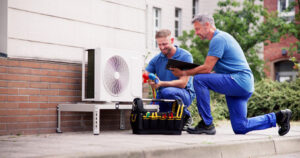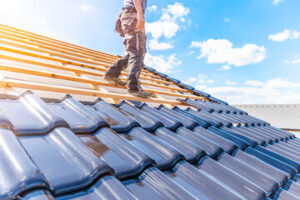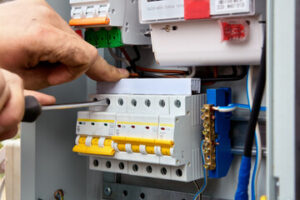HVAC systems provide personalized comfort control and improved indoor air quality for businesses, homes, and educational facilities. They operate in similar ways, but different types vary in size and functionality.

For example, ductless mini-split systems don’t require ductwork installation and allow for independent zone heating and cooling. But how do they work? Visit https://www.taphvac.com/ to learn more.
The system of heating, ventilation and air conditioning that is referred to as HVAC in your home or business is critical for keeping indoor environments comfortable and safe. These dedicated systems work in conjunction with one another to regulate temperature and humidity, purify the air of pollutants and allergens, and distribute a steady supply of oxygen throughout the building. They are crucial in the operation of residential structures like single-family homes and apartments as well as larger industrial, office, retail, or skyscraper buildings.
An HVAC system takes in air and either heats or cools it according to the season. They include a furnace, an air conditioner, and ductwork as well as thermostats. They also include an ENERGY STAR label and a reversing valve, which allows you to switch between heating and cooling.
During the winter, a furnace heats the air that circulates through your ductwork and out your vents to warm up your home. The heat that is produced by your furnace essentially comes from burning natural gas or oil. Depending on your preference, you may opt for a boiler system that uses water instead of fuel to produce heat.
Air conditioners are used to cool your space during the summer. To do this, they remove heat from the air by passing it over a cooled coil where it absorbs the heat before moving back through a compressor that pressurizes it into a liquid state. The refrigerant is then sent to the condenser coil where it turns into a gas again and is released outdoors through the fan.
The conditioned air is then distributed through your ducts for cooling and ventilation purposes. Other functions of a typical air conditioning unit are dehumidification and odor elimination. You can further refine the air quality with fans and filters for better air circulation and a healthier space. There are many options available for a ducted HVAC system including a duct-free option that eliminates the need for ductwork and can save you money. Regardless of what you choose, you can make the most out of your system by having routine maintenance done on a regular basis to prevent any problems before they arise.
Cooling
HVAC systems are vital to modern living, regulating temperature and air quality in homes and buildings everywhere. It’s not necessary to know the intricacies of how they work, but it’s helpful to understand the basics. An HVAC system takes in air, heats or cools it and then redirects the air back into a building. It can also include supplemental functions like ventilation, filters and dehumidification to improve indoor air quality.
The most commonly known function of HVAC is cooling, which enables a comfortable temperature in homes and offices. The cooling process removes heat from the air and distributes it throughout a building, typically through ductwork. Air conditioners, which are a type of HVAC system, use blowers to move air over the evaporator coil, cooling it and then blowing it into a house or office.
Most homeowners and businesses have central HVAC systems that consist of an indoor air handler, which houses most of the cooling system’s parts, and a condenser unit outside. Portable spot coolers and hybrid dual fuel systems, which combine an electric heat pump with a gas furnace, are alternatives to traditional air conditioning.
When choosing an HVAC system, it’s important to consider size and climate factors such as the average temperature, humidity level, and if the area is susceptible to extreme weather conditions in the summer or winter. The energy efficiency rating of an HVAC system is another important consideration, with higher ratings indicating lower operating costs.
When it comes to heating, cooling and ventilation, HVAC professionals are equipped with knowledge of how the system works and what components are required for optimum performance. This translates to the ability to properly diagnose and repair issues related to heating, cooling and ventilation and provide expert advice on how to improve energy efficiency. To ensure your home is comfortable year-round, schedule a maintenance service today. Regular service reduces energy bills, extends the life of equipment and helps prevent costly repairs. If you’re ready to discuss a new heating and cooling system, contact APEX today to learn more about our commercial HVAC and bulk duct fabrication services.
Ventilation
The air in your home is constantly changing, as outdoor air moves through the doors, windows and ventilation systems of the building. This natural exchange of air replenishes oxygen levels, reduces humidity, removes odors and filters carbon dioxide out.
However, relying on this kind of natural ventilation alone may not be enough to keep your home comfortable and healthy. Unless your home is built to a high standard, there’s a good chance you’ll need additional ventilation help from an HVAC system.
Ventilation is also essential for reducing indoor pollutants. Many common air pollutants like secondhand smoke, chemicals from cleaning products, dust, mold spores and even carbon dioxide can build up over time in your home, leading to health problems. These contaminants can be difficult or impossible to get rid of without adequate ventilation.
Fortunately, there are plenty of ways to improve your home’s ventilation, including duct-free systems that are ideal for homes with limited space or renovation projects. These systems feature individual units that are placed in each room of the home, allowing for better control over where the air is sent. These systems will also allow you to filter incoming air, ensuring that only the cleanest air is circulated throughout your home.
Duct-free systems can offer a number of other benefits, as well, such as eliminating wasted energy from heating and cooling unused rooms in the home. In addition, they can be more cost-effective than other forms of ventilation because they don’t require a lot of complicated installation work.
You can find a wide variety of ventilation systems in the marketplace, ranging from portable spot coolers to heat pumps with reversing valves that allow for switching between heating and cooling. These systems are designed to cool and ventilate your home by drawing in air through a refrigerant-cooled closed-loop coil. They then distribute cooled air through a series of vents to your home’s spaces.
It’s important to note that ventilation systems are not a replacement for other efforts to reduce indoor pollution, such as limiting smoking inside the home, keeping pets out of the lungs and using household cleaners with green ingredients. In addition, ventilation is not a solution for air quality issues caused by outside pollutants, such as smog or diesel emissions from nearby highways.
Thermostat
The thermostat is a small, yet incredibly important, part of your home’s heating system. Essentially the brains of your system, it tells the furnace when to turn on and off. It also regulates temperatures and directs the flow of warm air throughout your house. If your thermostat isn’t working correctly, it could be a sign that it needs to be repaired or replaced.
Thermostats come in a variety of models that are designed to suit various lifestyles and HVAC systems. However, they all operate on the same basic principles. Understanding how to choose a compatible thermostat can save you time, money, and headaches in the long run.
In its simplest form, a thermostat consists of a mercury switch that is connected to a blue wire. The switch is set in a metal case that is heated by a heating element. This heat causes the mercury to expand, and in turn, the current running through it will activate the switch. The hot mercury triggers the heating unit to turn on and distribute warm air. As the room begins to cool, the mercury shrinks back into place and triggers the cooling system to turn on.
Many modern thermostats are electronic. They have display screens and backlights, which can make them easy to read. Thermostats with digital displays can be programmed, and some have the ability to learn your habits and preferences. This information can then be used to automatically adjust your heating and cooling system’s temperature settings to maximize efficiency.
It is a good idea to consult the manual for your thermostat before attempting a self-diagnosis or troubleshooting process. There are specific instructions for testing, resetting, and repairing the device. If you are unable to resolve the problem yourself, it is always best to call in a professional for help.
A common cause of thermostat problems is improper installation. It is essential to find a location with good access to the air conditioning vents and avoid locations that are sunny, drafty, or obstructed. Thermostats that are mounted in these locations can have inaccurate readings, which can lead to high energy bills.



